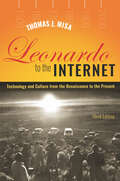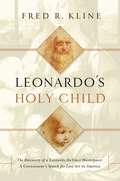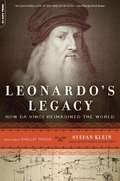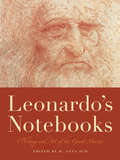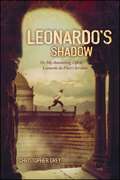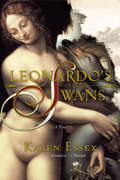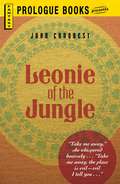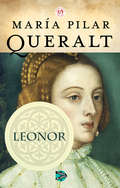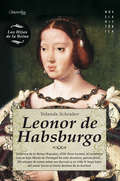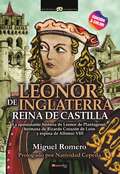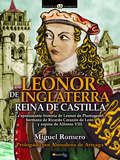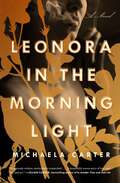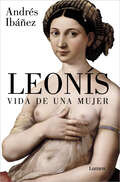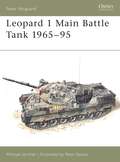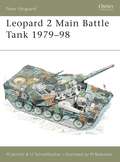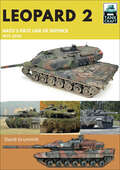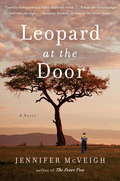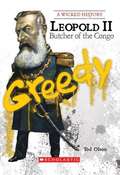- Table View
- List View
Leonardo to the Internet: Technology and Culture from the Renaissance to the Present (Johns Hopkins Studies in the History of Technology)
by Thomas J. MisaNow updated — A comprehensive, 500-year history of technology in society.Historian Thomas J. Misa's sweeping history of the relationship between technology and society over the past 500 years reveals how technological innovations have shaped—and have been shaped by—the cultures in which they arose. Spanning the preindustrial past, the age of scientific, political, and industrial revolutions, as well as the more recent eras of imperialism, modernism, and global security, this compelling work evaluates what Misa calls "the question of technology."In this edition, Misa brings his acclaimed text up to date by drawing on current scholarship while retaining sharply drawn portraits of individual people, artifacts, and systems. Each chapter has been honed to relate to contemporary concerns. Globalization, Misa argues, looks differently considering today's virulent nationalism, cultural chauvinism, and trade wars. A new chapter focuses on the digital age from 1990 to 2016. The book also examines how today's unsustainable energy systems, insecure information networks, and vulnerable global shipping have helped foster geopolitical risks and instability and takes a look at the coronavirus pandemic from the perspective of Wuhan, China's high-tech district. A masterful analysis of how technology and culture have influenced each other over five centuries, Leonardo to the Internet frames a history that illuminates modern-day problems and prospects faced by our technology-dependent world.
Leonardo's Brain: Understanding Da Vinci's Creative Genius
by Leonard ShlainBest-selling author Leonard Shlain explores the life, art, and mind of Leonardo da Vinci, seeking to explain his singularity by looking at his achievements in art, science, psychology, and military strategy and then employing state of the art left-right brain scientific research to explain his universal genius. Shlain shows that no other person in human history has excelled in so many different areas as da Vinci and he peels back the layers to explore the how and the why.Shlain asserts that Leonardo&’s genius came from a unique creative ability that allowed him to understand and excel in a wide range of fields. From here Shlain jumps off and discusses the history of and current research on human creativity that involves different modes of thinking and neuroscience .The author also boldly speculates on whether or not the qualities of Leonardo&’s brain and his creativity presage the future evolution of the human species.Leonardo&’s Brain uses da Vinci as a starting point for an exploration of human creativity. With his lucid style, and his remarkable ability to discern connections in a wide range of fields, Shlain brings the reader into the world of history&’s greatest mind. .
Leonardo's Foot
by Carol Ann RinzlerA Selection of the Scientific American, History, and BOMC2 Book Clubs"An in-depth look at the anatomy and history of feet reveals their often overlooked importance in human evolution, medicine and art." -Science News"Stylish, informative, entertaining, and pleasantly personal . . . Whether Rinzler is exploring how our feet explain or illuminate such topics as evolution, disability, racism, diet, or desire, she maintains a fascinating perspective on the peculiarities of being human." -Rain Taxi Review of Books"This neat little book draws a clear picture of our feet, providing understanding that extends far beyond the obvious. Readers often like to walk away from a book feeling they learned something-that the author left them with a new way to look at an old idea, and this book fulfills that need." -City Book Review"Rinzler lifts the lowly human foot to new heights in this appealing book." -Booklist (starred review)Leonardo's Foot stretches back to the fossil record and forward to recent discoveries in evolutionary science to demonstrate that it was our feet rather than our brains that first distinguished us from other species within the animal kingdom. Taking inspiration from Leonardo da Vinci's statement that "the human foot is a masterpiece of engineering and a work of art," Carol Ann Rinzler leads us on a fascinating stroll through science, medicine, and culture to shed light on the role our feet have played in the evolution of civilization.Whether discussing the ideal human form in classical antiquity, the impressive depth of the arching soles on the figures in Sandro Botticelli's Birth of Venus, an array of foot maladies and how they have affected luminaries from Lord Byron to Benjamin Franklin, or delving into the history of foot fetishism, Rinzler has created a wonderfully diverse catalog of details on our lowest extremities. This is popular science writing at its most entertaining-page after page of fascinating facts, based around the playful notion that appreciating this often overlooked part of our body is essential to understanding what it is to be human.Carol Ann Rinzler, a former nutrition columnist for the New York Daily News, has contributed to a number of publications, including the New York Times. She is the author of more than twenty books on health and medicine, including Nutrition for Dummies, an international bestseller translated into fourteen languages.
Leonardo's Holy Child: A Connoiseur's Search for Lost Art in America
by Fred R. KlineA single sketch becomes an all-consuming quest to understand and identify a work by Leonardo da Vinci himself--the first new drawing by the great master to have surfaced in over a century. Fred Kline is a well-known art historian, dealer, connoisseur, and explorer who has made a career of scouring antique stores, estate sales, and auctions looking for unusual--and often misidentified--works of art. Many of the gems he has found are now in major museum collections like the Frick, the Getty, and the Metropolitan Museum of Art. But this book is about the discovery of one piece in particular: About ten years ago, when Kline was routinely combing through a Christie's catalog, a beautiful little drawing caught his eye. Attributed to Carracci, it came with a very low estimate, but Kline's every instinct told him that the attribution was wrong. He placed a bid and the low asking price and bought the drawing outright. And that was the beginning of how Kline discovered Leonardo da Vinci's model drawing for the Infant Jesus and the Infant St. John. It is the first work by da Vinci to have surfaced in over a century. Leonardo's Holy Child chronicles not only the story of this amazing discovery, from Kline's research all over the world to how exactly attributions work with regards to the old masters (most of their works are unsigned). Kline also sheds light on the idea of "connoisseurship," an often-overlooked facet of art history that's almost Holmesian in its intricacy and specificity.
Leonardo's Legacy: How Da Vinci Reimagined the World
by Stefan KleinRevered today as, perhaps, the greatest of Renaissance painters, Leonardo da Vinci was a scientist at heart. The artist who created theMona Lisaalso designed functioning robots and digital computers, constructed flying machines and built the first heart valve. His intuitive and ingenious approach-a new mode of thinking-linked highly diverse areas of inquiry in startling new ways and ushered in a new era. InLeonardo’s Legacy, award-winning science journalist Stefan Klein deciphers the forgotten legacy of this universal genius and persuasively demonstrates that today we have much to learn from Leonardo’s way of thinking. Klein sheds light on the mystery behind Leonardo’s paintings, takes us through the many facets of his fascination with water, and explains the true significance of his dream of flying. It is a unique glimpse into the complex and brilliant mind of this inventor, scientist, and pioneer of a new world view, with profound consequences for our times.
Leonardo's Notebooks: Writing and Art of the Great Master (Notebook Series)
by Leonardo Da Vinci H. Anna SuhAn all-new, jewel-like, reader-friendly format gives new life to this relaunch of an international best-seller.Leonardo da Vinci?artist, inventor, and prototypical Renaissance man?is a perennial source of fascination because of his astonishing intellect and boundless curiosity about the natural and man-made world. During his life he created numerous works of art and kept voluminous notebooks that detailed his artistic and intellectual pursuits.The collection of writings and art in this magnificent book are drawn from his notebooks. The book organizes his wide range of interests into subjects such as human figures, light and shade, perspective and visual perception, anatomy, botany and landscape, geography, the physical sciences and astronomy, architecture, sculpture, and inventions. Nearly every piece of writing throughout the book is keyed to the piece of artwork it describes.The writing and art is selected by art historian H. Anna Suh, who provides fascinating commentary and insight into the material, making Leonardo's Notebooks an exquisite single-volume compendium celebrating his enduring genius.
Leonardo's Shadow
by Christopher GreyMilan, 1497. The height of the Renaissance. And for Giacomo, servant of the famous painter Leonardo da Vinci, it's the most difficult time of all. His Master has been working on the Last Supper, his greatest painting ever, for nearly two years. But has he finished it? He's barely started! The all-powerful Duke of Milan is demanding that it be completed by the time the Pope visits at Easter. And Giacomo knows that if Leonardo doesn't pick up his pace, the Duke may invite a young genius -- Michelangelo -- to finish the painting instead. Which means that Leonardo won't be paid, which means that Milan's shopkeepers (to whom he owes massive amounts) will take drastic measures against him. It's all down to Giacomo, and whether he can come up with a brilliant solution. And if he does, will his Master go for it? After all, Leonardo still doesn't seem to trust him. He refuses to teach Giacomo how to paint; he won't help him find his parents; nor will he discuss the significance of the medallion, ring, and cross that Giacomo was carrying when Leonardo found him. But with the secret arrival of a powerful stranger, Giacomo is about to discover much more than the answers he has been looking for. And he will also receive an invitation to help arrange a meeting that could change his life. . . and the future course of history. With more twists and turns than a spiral staircase, this thriller is as unique as its two heroes -- the most celebrated artist who ever lived, and a young man without a past, who will stop at nothing to find the truth about his life.
Leonardo's Swans
by Karen EssexIsabelle d'Este, daughter of the Duke of Ferrara, born into privilege and the political and artistic turbulence of Renaissance Italy, is a stunning black-eyed blond and an art lover and collector. Worldly and ambitious, she has never envied her less attractive sister, the spirited but naïve Beatrice, until, by a quirk of fate, Beatrice is betrothed to the future Duke of Milan. Although he is more than twice their age, openly lives with his mistress, and is reputedly trying to eliminate the current duke by nefarious means, Ludovico Sforza is Isabella's match in intellect and passion for all things of beauty. Only he would allow her to fulfill her destiny: to reign over one of the world's most powerful and enlightened realms and be immortalized in oil by the genius Leonardo da Vinci. Isabella vows that she will not rest until she wins her true fate, and the two sisters compete for supremacy in the illustrious courts of Europe. A haunting novel of rivalry, love, and betrayal that transports you back to Renaissance Italy, Leonardo's Swans will have you dashing to the works of the great master--not for clues to a mystery but to contemplate the secrets of the human heart.
Leonardo: A Biographical Novel
by Curtis Bill PepperThis compelling novel takes the reader into the tumultuous period of the Renaissance and the origins of Leonardo da Vinci, the bastard child of a notary. Of da Vinci, the eminent art historian Kenneth Clark wrote, &“no more complex and mysterious character ever existed than this Hamlet of art history.&” Clark noted that one had to be &“familiar with all of Leonardo&’s writings in their chronological order (and) the state of learning in the Renaissance to judge Leonardo&’s progress in relation to that of his contemporaries.&”This compelling novel takes the reader into the tumultuous period of the Renaissance and the origins of Leonardo da Vinci, the bastard child of a notary. Of da Vinci, the eminent art historian Kenneth Clark wrote, &“no more complex and mysterious character ever existed than this Hamlet of art history.&” Clark noted that one had to be &“familiar with all of Leonardo&’s writings in their chronological order (and) the state of learning in the Renaissance to judge Leonardo&’s progress in relation to that of his contemporaries.&”
Leonardo’s Shadow: Or, My Astonishing Life as Leonardo da Vinci's Servant
by Christopher GreyMilan, 1497. The height of the Renaissance. And for Giacomo, servant of the famous painter Leonardo da Vinci, it's the most difficult time of all. His Master has been working on the Last Supper, his greatest painting ever, for nearly two years. But has he finished it? He's barely started! The all-powerful Duke of Milan is demanding that it be completed by the time the Pope visits at Easter.
Leonhard Euler
by Ronald S. CalingerThis is the first full-scale biography of Leonhard Euler (1707-83), one of the greatest mathematicians and theoretical physicists of all time. In this comprehensive and authoritative account, Ronald Calinger connects the story of Euler's eventful life to the astonishing achievements that place him in the company of Archimedes, Newton, and Gauss. Drawing chiefly on Euler's massive published works and correspondence, which fill more than eighty volumes so far, this biography sets Euler's work in its multilayered context--personal, intellectual, institutional, political, cultural, religious, and social. It is a story of nearly incessant accomplishment, from Euler's fundamental contributions to almost every area of pure and applied mathematics--especially calculus, number theory, notation, optics, and celestial, rational, and fluid mechanics--to his advancements in shipbuilding, telescopes, ballistics, cartography, chronology, and music theory.The narrative takes the reader from Euler's childhood and education in Basel through his first period in St. Petersburg, 1727-41, where he gained a European reputation by solving the Basel problem and systematically developing analytical mechanics. Invited to Berlin by Frederick II, Euler published his famous Introductio in analysin infinitorum, devised continuum mechanics, and proposed a pulse theory of light. Returning to St. Petersburg in 1766, he created the analytical calculus of variations, developed the most precise lunar theory of the time that supported Newton's dynamics, and published the best-selling Letters to a German Princess--all despite eye problems that ended in near-total blindness. In telling the remarkable story of Euler and how his achievements brought pan-European distinction to the Petersburg and Berlin academies of sciences, the book also demonstrates with new depth and detail the central role of mathematics in the Enlightenment.Some images inside the book are unavailable due to digital copyright restrictions.
Leonie of the Jungle
by Joan Conquest''I think I am bewitched - something is - is - pulling - is . . .”Death and despair are never far behind the beautiful Leonie Hetth. Orphaned in India at four months old and raised by her vapid, aging maiden aunt in cold, wet England, Leonie has no one to turn to when her nightmares begin taking their toll on those around her. Only young brain surgeon Jonathan Cuxson, Jr., seems to understand her. Following in his late father’s footsteps, he’s determined to discover the root of Leonie’s destructive bouts of sleepwalking and unconscious Hindustani mutterings. And somewhere, deep in the jungle, a mad priest waits patiently for his entranced human sacrifice to reach India’s shores . . .
Leonor
by María Pilar QueraltLeonor, esposa de Fernando I el Hermoso, rey de Portugal. Para unos, intrigante y adúltera. Para otros, culpable de la crisis política y económica que afectó a Portugal en el siglo XIV. Bella, ambiciosa e inteligente, fue una mujer libre que se adelantó a su tiempo. Entre amores y desamores, pasión y muerte, la vida de Leonor no ahorra ni siquiera pactos con el diablo para conservar su independencia.Una historia que implica por igual a Portugal y Castilla.
Leonor de Aquitania
by Pamela KaufmanLeonor de Aquitania, la mujer que cambió el destino de las coronas de Francia e Inglaterra. Esta es la historia de Leonor de Aquitania, una de las mujeres más interesantes de la Europa del medioevo. Nacida en 1112, estuvo primero casada durante diez tormentosos años con Luis VII, rey de Francia, un ferviente devoto que la obligó a partir con él a la Segunda Cruzada. La experiencia despertó en la joven deseos de libertad e independencia. Por lo que decidió emplear todas sus influencias para forzar al Papa anular el desgraciado matrimonio con el monarca francés. Leonor intentó entonces casarse con un amor de juventud, pero obligada a desposarse con el rey inglés Enrique II Plantagenet. En este escenario, la duquesa de Aquitania luchó por sus derechos y los de sus hijos -entre ellos, el legendario Ricardo Corazón de León- hasta los últimos días de su longeva e intensa vida.
Leonor de Habsburgo (Historia Incógnita)
by Yolanda ScheuberYolanda Scheuber, utilizando la muy conocida técnica del racconto y recurriendo, asimismo, al narrador en primera persona, logra construir en esta novela la vida de Leonor de Habsburgo, hija de Juana I de Castilla (la Loca) y de Felipe de Austria (el Hermoso). Así, en los últimos instantes de su vida, Leonor empezará a rememorar su historia, cargada sobre todo por el peso de la obediencia. Aun cuando Leonor estuvo destinada a hacer flamear la divisa de los Habsburgo y llegó a ser reina de Portugal y reina de Francia, actualmente existe muy poca bibliografía sobre ella. A pesar de esto, la autora ha conseguido desarrollar una novela histórica sólidamente documentada. Consigue transmitir con gran verosimilitud la vida palaciega, los problemas políticos, las alianzas entre reinos, los intereses desmedidos y las ambiciones descontroladas… propias de aquellos tiempos en los que Carlos V, obligó a su hermana Leonor a anteponer el deber a la felicidad.
Leonor de Inglaterra, Reina de Castilla N.E. color (Historia Incógnita)
by Miguel RomeroLa dama inglesa, consorte de Alfonso VIII, que revolucionó la cultura de la Castilla medieval del siglo XIII
Leonor de Inglaterra. Reina de Castilla (Historia Incógnita)
by Miguel RomeroLa dama inglesa, consorte de Alfonso VIII, que revolucionó la cultura de la Castilla medieval del siglo XIII Leonor de Plantagenet o de Inglaterra, reina consorte de Castilla, es un riguroso ensayo centrado en la vida y obra cultural de Leonor de Inglaterra, hija de Leonor de Aquitania, envuelta en la época medieval de una Castilla reconquistadora que intentaba configurar su propio mapa jurisdiccional, gracias a la gran labor de su esposo, el rey castellano Alfonso VIII. La que fuera reina de Castilla representó, para la Europa de la última mitad del siglo XII y la primera del XIII, un nuevo concepto del espacio femenino, heredado de su madre, Leonor de Aquitania, la que fuera reina de Francia y de Inglaterra, y prototipo de mujer universal. En esta Historia Incógnita, Miguel Romero afronta también los pasajes más importantes de la vida política de Alfonso VIII, su esposo, y un breve recorrido por la vida de su madre, personajes sin los que sería imposible entender adecuadamente la vida de la protagonista. Leonor, precursora del desarrollo de la lírica trovadoresca, procedente de la Occitania francesa, abrió la puerta al juglarismo más cortesano y al cultismo popular. Ayudó a potenciar las ideas constructivas del Cister y fue precursora de la aplicación del primer gótico en las catedrales de Sigüenza y Cuenca, promoviendo la construcción de las Huelgas y el Hospital del Rey en Burgos. La fascinante biografía de una mujer fuera de su tiempo que vivió la Castilla reconquistadora del siglo XIII con pasión y con amor.
Leonora in the Morning Light: A Novel
by Michaela Carter*One of Oprah Daily&’s Most Anticipated Historical Fiction Novels That Will Sweep You Away* &“Michaela Carter&’s training as a poet and painter shines through from the first page of this vivid, gorgeous novel based on the lives of Leonora Carrington and Max Ernst. Told with all the wild magic and mystery of the Surrealists themselves, Leonora in the Morning Light fearlessly illuminates the life and work of a formidable female artist.&” —Whitney Scharer, bestselling author of The Age of Light For fans of Amy Bloom&’s White Houses and Colm Tóibín&’s The Master, a &“gorgeously written, meticulously researched&” (Jillian Cantor, bestselling author of Half Life) novel about Surrealist artist Leonora Carrington and the art, drama, and romance that defined her coming-of-age during World War II.1940. A train carrying exiled German prisoners from a labor camp arrives in southern France. Within moments, word spreads that Nazi capture is imminent, and the men flee for the woods, desperate to disappear across the Spanish border. One stays behind, determined to ride the train until he reaches home, to find a woman he refers to simply as &“her.&” 1937. Leonora Carrington is a twenty-year-old British socialite and painter when she meets Max Ernst, an older, married artist whose work has captivated Europe. She follows him to Paris, into the vibrant world of studios and cafes where rising visionaries of the Surrealist movement like Andre Breton, Pablo Picasso, Lee Miller, Man Ray, and Salvador Dali are challenging conventional approaches to art and life. Inspired by their freedom, Leonora begins to experiment with her own work, translating vivid stories of her youth onto canvas and gaining recognition under her own name. It is a bright and glorious age of enlightenment—until war looms over Europe and headlines emerge denouncing Max and his circle as &“degenerates,&” leading to his arrest and imprisonment. Left along as occupation spreads throughout the countryside, Leonora battles terrifying circumstances to survive, reawakening past demons that threaten to consume her. As Leonora and Max embark on remarkable journeys together and apart, the full story of their tumultuous and passionate love affair unfolds, spanning time and borders as they seek to reunite and reclaim their creative power in a world shattered by war. When their paths cross with Peggy Guggenheim, an art collector and socialite working to help artists escape to America, nothing will be the same. Based on true events and historical figures, Leonora in the Morning Light is &“a deeply involving historical tale of tragic lost love, determined survival, the sanctuary of art, and the evolution of a muse into an artist of powerfully provocative feminist expression&” (Booklist, starred review).
Leonís. Vida de una mujer
by ANDRÉS IBÁÑEZUNA HISTORIA DE ESPAÑA COMO NUNCA SE HA CONTADOEL ORLANDO ESPAÑOL, POR EL GANADOR DEL PREMIO NACIONAL DE LA CRÍTICA Y EL PREMIO OJO CRÍTICO «Leonís confirma que no hay nadie como él en nuestra literatura».Eduardo Lago «Simplemente, un genio».Miguel Dalmau, La Vanguardia Inés de Padilla nace en 1469 y con quince años logra entrar en la Universidad de Salamanca en un momento en el que los estudios estaban vedados a las mujeres salvo en casos excepcionales como el de Beatriz Galindo. Allí conoce al hombre con el que mantendrá una larga historia intermitente de amor. Ya en Madrid, entra en la corte de los Reyes Católicos y se convierte en dama de Juana la Loca. Amante de Juan de Padilla, participa en la revuelta de los comuneros. Pero, a comienzos del siglo XVI, se percata de un hecho inexplicable: no ha envejecido ni un solo día desde que cumplió veinticinco años. Y así sigue viviendo, sorteando peligros, hasta los albores del siglo XXI. Esta asombrosa novela de aventuras, en la que la ficción se entrelaza con maestría con la realidad, constituye un homenaje a la literatura española. En ella resuenan los ecos del Orlando de Virginia Woolf pero, por encima de todo, es una narración de largo aliento sobre la historia de España y sobre el papel determinante que las mujeres han desempeñado en ella a través del tiempo. La crítica ha dicho:«He seguido su trayectoria con asombro creciente. Leonís confirma que no hay nadie como él en nuestra literatura».Eduardo Lago «Como narrador podría hacer todo lo que se propusiera [...]. Si hay un escritor que gusta de probar cosas nuevas, pese a los rasgos muy constantes y reconocibles de su universo, ese es Ibáñez».Nadal Suau, El Cultural «Puede que Andrés Ibáñez sea el mejor escritor de su generación».J. M. Pozuelo Yvancos, ABC Cultural «Simplemente, un genio».Miguel Dalmau, La Vanguardia «Un escritor audaz que cuenta con seguidores de culto entre aquellos que buscan una alternativa a la escritura más naturalista».The Times Literary Supplement «No es solo un gran maestro de la literatura, un autor profundamente original y uno de los más grandes novelistas españoles vivos: es también un escritor fundamental para entendernos a nosotros mismos en esta extraña época del mundo».Ismael Belda, Revista de Libros «Un inmenso libro sobre el fin de las creencias».Inés Martín Rodrigo, ABC (sobre Brilla, mar del Edén) «Acaso sea esta la novela que —de haber podido— les hubiera gustado escribir a los autores de las series actuales de mayor éxito».Fernando Valls, Babelia (sobre Brilla, mar del Edén)
Leopard 1 Main Battle Tank 1965-95
by Peter Sarson Michael JerchelDevelopment of the Leopard 1 can be traced back to November 1956, when the operational requirement for a new battle tank was formulated by the Federal German Armed Forces (Bundeswehr). Originally a Franco-German project, the tank under design was named the 'Standard-Panzer'. The French later dropped out, however, and on 1 October 1963 the 'Standard' tank was officially named 'Leopard', an appropriate choice considering Germany's wartime pedigree with the formidable Tiger and Panther. This book traces the development and service record of the Leopard 1, detailing its control systems, modifications and variants.
Leopard 2 Main Battle Tank 1979-98
by Michael Jerchel Mike BadrockeIn 1963 West Germany and the United States signed an agreement to develop the best tank in the world - the MBT/KPz-70. Though by 1970 this project was stopped, West Germany used the components created for the MBT/KPz-70 to develop a new main battle tank - the Leopard 2. Since 1979, when the first Leopard 2 rolled off the production line, the Leopard 2 has undergone various modifications, and has been exported to various European countries. Enhanced by Osprey's signature colour plates and cutaway artwork, this book examines the development of the Leopard 2 from the first batch to its evolution into the improved Leopard 2 A5, detailing its features and variants.
Leopard 2: NATO's First Line of Defence, 1979–2020 (TankCraft #28)
by David GrummittA modeler’s guide to one of the most powerful tanks operating today: “Highly recommended.” —AMPS IndianapolisWhen the Leopard 2, a third-generation main battle tank, first entered service with the Bundeswehr in 1979, at the height of the Cold War, it was indisputably the most advanced and potent tank in the world. Over four decades it has undergone numerous upgrades and modifications to ensure it remains one of the most powerful tanks operating today. It currently serves with the armies of seventeen nations, from Canada to Turkey and many European states.The Leopard 2 is also a popular subject for modelers, which is why David Grummitt’s highly illustrated expert guide is so valuable. As well as describing in detail the Leopard 2’s design, development, and combat history, he gives a full account of the wide range of modeling kits and accessories available in all the popular scales. Included is a modeling gallery, which features six builds covering a range of Leopard 2s serving with different nations and a section of large-scale color profiles which provide both reference and inspiration for modelers and military enthusiasts alike.
Leopard at the Door
by Jennifer McveighSet in Kenya in the 1950s against the fading backdrop of the British Empire, a story of self-discovery, betrayal, and an impossible love. After six years in England, Rachel has returned to Kenya and the farm where she spent her childhood, but the beloved home she’d longed for is much changed. Her father’s new companion—a strange, intolerant woman—has taken over the household. The political climate in the country grows more unsettled by the day and is approaching the boiling point. And looming over them all is the threat of the Mau Mau, a secret society intent on uniting the native Kenyans and overthrowing the whites. As Rachel struggles to find her place in her home and her country, she initiates a covert relationship, one that will demand from her a gross act of betrayal. One man knows her secret, and he has made it clear how she can buy his silence. But she knows something of her own, something she has never told anyone. And her knowledge brings her power.From the Hardcover edition.
Leopold III and the Belgian Royal Question
by E. Ramón ArangoOriginally published in 1963. Between 1945 and 1951, Belgium faced a crisis in political leadership when its ruling monarch, King Leopold III, was accused of violating the Belgian Constitution during World War II. The "question" at hand refers to the uncertainty over whether King Leopold III could return to Belgium as king. Leopold III and the Belgian Royal Question documents the history of this political crisis, culminating with the abdication of King Leopold and the assumption of the crown by Baudouin, Leopold's son.
